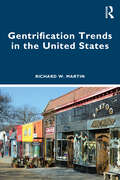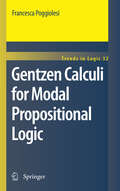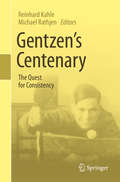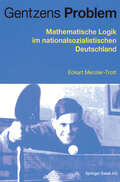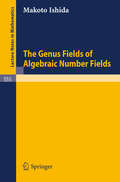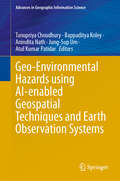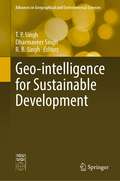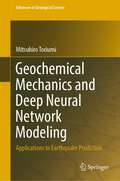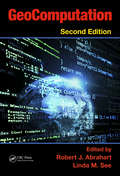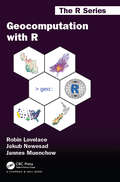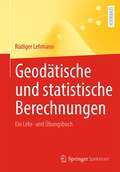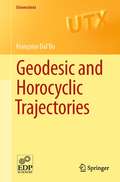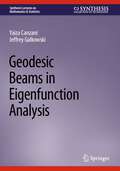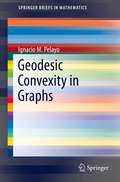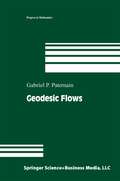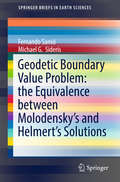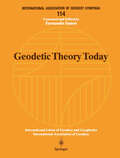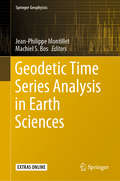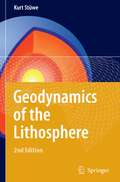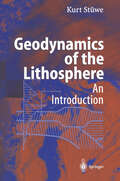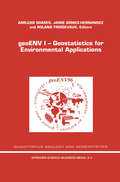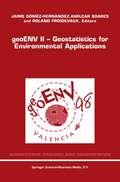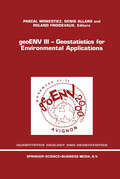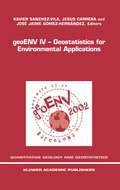- Table View
- List View
Gentrification Trends in the United States
by Richard W. MartinGentrification Trends in the United States is the first book to quantify the changes that take place when a neighborhood’s income level, educational attainment, or occupational makeup outpace the city as a whole – the much-debated yet poorly understood phenomenon of gentrification. Applying a novel method to four decades of U.S. Census data, this resource for students and scholars provides a quantitative basis for the nuanced demographic trends uncovered through ethnography and other forms of qualitative research. This analysis of a rich data source characterized by a broad regional and chronological scope provides new insight into larger questions about the nature and prevalence of gentrification across the United States. Has gentrification become more common over time? Which cities have experienced the most gentrification? Is gentrification widespread, or does it tend to be concentrated in a small number of cities? Has the nature of gentrification changed over time? Ideal reading for courses in real estate, urban planning, urban economics, sociology, geography, econometrics, and GIS, this pathbreaking addition to the urban studies literature will enrich the perspective of any scholar of U.S. cities.
Gentzen Calculi for Modal Propositional Logic (Trends in Logic #32)
by Francesca PoggiolesiThe book is about Gentzen calculi for (the main systems of) modal logic. It is divided into three parts. In the first part we introduce and discuss the main philosophical ideas related to proof theory, and we try to identify criteria for distinguishing good sequent calculi. In the second part we present the several attempts made from the 50’s until today to provide modal logic with Gentzen calculi. In the third and and final part we analyse new calculi for modal logics, called tree-hypersequent calculi, which were recently introduced by the author. We show in a precise and clear way the main results that can be proved with and about them.
Gentzen's Centenary: The Quest for Consistency
by Reinhard Kahle Michael RathjenGerhard Gentzen has been described as logic’s lost genius, whom Gödel called a better logician than himself. This work comprises articles by leading proof theorists, attesting to Gentzen’s enduring legacy to mathematical logic and beyond. The contributions range from philosophical reflections and re-evaluations of Gentzen’s original consistency proofs to the most recent developments in proof theory. Gentzen founded modern proof theory. His sequent calculus and natural deduction system beautifully explain the deep symmetries of logic. They underlie modern developments in computer science such as automated theorem proving and type theory.
Gentzens Problem: Mathematische Logik im nationalsozialistischen Deutschland
by Eckart Menzler-TrottGerhard Gentzen (1909-1945) ist der Begründer der modernen mathematischen Beweistheorie. Die nachhaltige Bedeutung seiner Arbeiten zeigt sich bis heute in der Informatik und beeindruckt durch Einsicht und Eleganz. Der Autor dokumentiert in dieser ersten umfassenden Biografie Leben und Werk Gerhard Gentzens, seinen tragischen Lebensweg: Festnahme 1945 in Prag, Gefangenschaft und Tod. Plus: zahlreiche, bislang unveröffentlichte Dokumente und Fotos.
Geo-Environmental Hazards using AI-enabled Geospatial Techniques and Earth Observation Systems (Advances in Geographic Information Science)
by Jung-Sup Um Tanupriya Choudhury Bappaditya Koley Anindita Nath Atul Kumar PatidarThis edited collection provides a comprehensive exploration of cutting-edge ideas, approaches, simulations, evaluations of risk, and systems that enhance the practicality of current geospatial technologies for reducing hazard risks. The various sections within this book delve into subjects such as the foundational principles of Earth Observation Systems (EOS) and geospatial methodologies. Additionally, the text serves as an advisory resource on the collaborative use of satellite-derived data and artificial intelligence to track and alleviate geo-environmental threats. The volume imparts extensive understanding regarding geo-environmental dangers and their analysis via EOS along with geospatial strategies. It encompasses key hazard-related themes including coastal degradation, predisposition to landslides, mapping vegetation coverages, tropical storm patterns, soil depletion due to erosion processes, vulnerability to rapid or extended flooding events, variations in oceansurface temperatures alongside chlorophyll-a levels; it also addresses assessments related to groundwater reserves and quality measures as well as sustainable management practices for watersheds that support community livelihoods—all through leveraging AI-integrated geospatial tools in conjunction with earth observation technologies. Furthermore, this work engages in discourse about systems designed for mitigating these ecological challenges sustainably. Scholars engaged in research activities; educational professionals; those involved in landscape design; engineers working at ground level; individuals responsible for policy-making—all who are concerned with geo-environmental hazards or associated domains—will find valuable insights within these pages.
Geo-intelligence for Sustainable Development (Advances in Geographical and Environmental Sciences)
by T. P. Singh Dharmaveer Singh R. B. SinghGlobally, concerns for the environment and human well-being have increased as results of threats imposed by climate change and disasters, environmental degradation, pollution of natural resources, water scarcity and proliferation of slums. Finding appropriate solutions to these threats and challenges is not simple, as these are generally complex and require state-of-the-art technology to collect, measure, handle and analyse large volumes of varying data sets. However, the recent advances in sensor technology, coupled with the rapid development of computational power, have greatly enhanced our abilities to capture, store and analyse the surrounding physical environment. This book explores diverse dimensions of geo-intelligence (GI) technology in developing a computing framework for location-based, data-integrating earth observation and predictive modelling to address these issues at all levels and scales. The book provides insight into the applications of GI technology in several fields of spatial and social sciences and attempts to bridge the gap between them.
Geochemical Mechanics and Deep Neural Network Modeling: Applications to Earthquake Prediction (Advances in Geological Science)
by Mitsuhiro ToriumiThe recent understandings about global earth mechanics are widely based on huge amounts of monitoring data accumulated using global networks of precise seismic stations, satellite monitoring of gravity, very large baseline interferometry, and the Global Positioning System. New discoveries in materials sciences of rocks and minerals and of rock deformation with fluid water in the earth also provide essential information. This book presents recent work on natural geometry, spatial and temporal distribution patterns of various cracks sealed by minerals, and time scales of their crack sealing in the plate boundary. Furthermore, the book includes a challenging investigation of stochastic earthquake prediction testing by means of the updated deep machine learning of a convolutional neural network with multi-labeling of large earthquakes and of the generative autoencoder modeling of global correlated seismicity. Their manifestation in this book contributes to the development of human society resilient from natural hazards. Presented here are (1) mechanics of natural crack sealing and fluid flow in the plate boundary regions, (2) large-scale permeable convection of the plate boundary, (3) the rapid process of massive extrusion of plate boundary rocks, (4) synchronous satellite gravity and global correlated seismicity, (5) Gaussian network dynamics of global correlated seismicity, and (6) prediction testing of plate boundary earthquakes by machine learning and generative autoencoders.
GeoComputation
by Robert J. Abrahart Linda M. SeeA revision of Openshaw and Abrahart's seminal work, GeoComputation, Second Edition retains influences of its originators while also providing updated, state-of-the-art information on changes in the computational environment. In keeping with the field's development, this new edition takes a broader view and provides comprehensive coverage across the
Geocomputation with R (Chapman & Hall/CRC The R Series)
by Robin Lovelace Jakub Nowosad Jannes MuenchowGeocomputation with R is for people who want to analyze, visualize and model geographic data with open source software. It is based on R, a statistical programming language that has powerful data processing, visualization, and geospatial capabilities. The book equips you with the knowledge and skills to tackle a wide range of issues manifested in geographic data, including those with scientific, societal, and environmental implications. This book will interest people from many backgrounds, especially Geographic Information Systems (GIS) users interested in applying their domain-specific knowledge in a powerful open source language for data science, and R users interested in extending their skills to handle spatial data. The book is divided into three parts: (I) Foundations, aimed at getting you up-to-speed with geographic data in R, (II) extensions, which covers advanced techniques, and (III) applications to real-world problems. The chapters cover progressively more advanced topics, with early chapters providing strong foundations on which the later chapters build. Part I describes the nature of spatial datasets in R and methods for manipulating them. It also covers geographic data import/export and transforming coordinate reference systems. Part II represents methods that build on these foundations. It covers advanced map making (including web mapping), "bridges" to GIS, sharing reproducible code, and how to do cross-validation in the presence of spatial autocorrelation. Part III applies the knowledge gained to tackle real-world problems, including representing and modeling transport systems, finding optimal locations for stores or services, and ecological modeling. Exercises at the end of each chapter give you the skills needed to tackle a range of geospatial problems. Solutions for each chapter and supplementary materials providing extended examples are available at https://geocompr.github.io/geocompkg/articles/.
Geocomputation with R (Chapman & Hall/CRC The R Series)
by Robin Lovelace Jakub Nowosad Jannes MuenchowGeocomputation with R is for people who want to analyze, visualize and model geographic data with open source software. It is based on R, a statistical programming language that has powerful data processing, visualization, and geospatial capabilities. The book equips you with the knowledge and skills to tackle a wide range of issues manifested in geographic data, including those with scientific, societal, and environmental implications. This book will interest people from many backgrounds, especially Geographic Information Systems (GIS) users interested in applying their domain-specific knowledge in a powerful open source language for data science, and R users interested in extending their skills to handle spatial data. The book is divided into three parts: (I) Foundations, aimed at getting you up-to-speed with geographic data in R, (II) extensions, which covers advanced techniques, and (III) applications to real-world problems. The chapters cover progressively more advanced topics, with early chapters providing strong foundations on which the later chapters build. Part I describes the nature of spatial datasets in R and methods for manipulating them. It also covers geographic data import/export and transforming coordinate reference systems. Part II represents methods that build on these foundations. It covers advanced map making (including web mapping), "bridges" to GIS, sharing reproducible code, and how to do cross-validation in the presence of spatial autocorrelation. Part III applies the knowledge gained to tackle real-world problems, including representing and modeling transport systems, finding optimal locations for stores or services, and ecological modeling. Exercises at the end of each chapter give you the skills needed to tackle a range of geospatial problems. Solutions for each chapter and supplementary materials providing extended examples are available at https://geocompr.github.io/geocompkg/articles/.
Geodätische und statistische Berechnungen: Ein Lehr- und Übungsbuch
by Rüdiger LehmannDieses Lehr- und Übungsbuch richtet sich an Sie als Studierende und praktisch tätige Fachleute der Geodäsie, der Geomatik, der Vermessung, der Ingenieurmathematik und verwandter Fachrichtungen. Sie erhalten ein theoretisches Grundgerüst, um geodätische und statistische Berechnungen selbst ausführen und fachspezifische Softwareprodukte sachkundig und professionell benutzen zu können.Das Buch enthält 92 teils ganzseitige, farbige Abbildungen und 160 praktische Zahlenbeispiele. Mit deren Hilfe können Sie die vorgestellten Berechnungsverfahren nicht nur theoretisch nachvollziehen, sondern lernen auch deren praktische Anwendung kennen. Weiterhin finden Sie 111 Aufgaben, die Sie selbst lösen und mit den angegebenen Ergebnissen vergleichen können. Die meisten Berechnungen lassen sich auch mit einer kostenlosen Online-Software nachvollziehen, auf die unter den Beispielen und Aufgaben verlinkt wird. Bei der Lektüre kommen Sie ohne besondere mathematische und geodätische Spezialkenntnisse aus. Die praktischen Beispiele und Aufgaben sind sämtlich aus den Bereichen Tachymetrie, Nivellement und den Grundlagen der Satellitennavigation gewählt.
Geodesic and Horocyclic Trajectories (Universitext)
by Françoise Dal’BoGeodesic and Horocyclic Trajectories presents an introduction to the topological dynamics of two classical flows associated with surfaces of curvature −1, namely the geodesic and horocycle flows. Written primarily with the idea of highlighting, in a relatively elementary framework, the existence of gateways between some mathematical fields, and the advantages of using them, historical aspects of this field are not addressed and most of the references are reserved until the end of each chapter in the Comments section. Topics within the text cover geometry, and examples, of Fuchsian groups; topological dynamics of the geodesic flow; Schottky groups; the Lorentzian point of view and Trajectories and Diophantine approximations.
Geodesic Beams in Eigenfunction Analysis (Synthesis Lectures on Mathematics & Statistics)
by Yaiza Canzani Jeffrey GalkowskiThis book discusses the modern theory of Laplace eigenfunctions through the lens of a new tool called geodesic beams. The authors provide a brief introduction to the theory of Laplace eigenfunctions followed by an accessible treatment of geodesic beams and their applications to sup norm estimates, L^p estimates, averages, and Weyl laws. Geodesic beams have proven to be a valuable tool in the study of Laplace eigenfunctions, but their treatment is currently spread through a variety of rather technical papers. The authors present a treatment of these tools that is accessible to a wider audience of mathematicians. Readers will gain an introduction to geodesic beams and the modern theory of Laplace eigenfunctions, which will enable them to understand the cutting edge aspects of this theory.
Geodesic Convexity in Graphs (SpringerBriefs in Mathematics)
by Ignacio M. PelayoGeodesic Convexity in Graphs is devoted to the study of the geodesic convexity on finite, simple, connected graphs. The first chapter includes the main definitions and results on graph theory, metric graph theory and graph path convexities. The following chapters focus exclusively on the geodesic convexity, including motivation and background, specific definitions, discussion and examples, results, proofs, exercises and open problems. The main and most studied parameters involving geodesic convexity in graphs are both the geodetic and the hull number which are defined as the cardinality of minimum geodetic and hull set, respectively. This text reviews various results, obtained during the last one and a half decade, relating these two invariants and some others such as convexity number, Steiner number, geodetic iteration number, Helly number, and Caratheodory number to a wide range a contexts, including products, boundary-type vertex sets, and perfect graph families. This monograph can serve as a supplement to a half-semester graduate course in geodesic convexity but is primarily a guide for postgraduates and researchers interested in topics related to metric graph theory and graph convexity theory.
Geodesic Flows (Progress in Mathematics #180)
by Gabriel P. PaternainThe aim of this book is to present the fundamental concepts and properties of the geodesic flow of a closed Riemannian manifold. The topics covered are close to my research interests. An important goal here is to describe properties of the geodesic flow which do not require curvature assumptions. A typical example of such a property and a central result in this work is Mane's formula that relates the topological entropy of the geodesic flow with the exponential growth rate of the average numbers of geodesic arcs between two points in the manifold. The material here can be reasonably covered in a one-semester course. I have in mind an audience with prior exposure to the fundamentals of Riemannian geometry and dynamical systems. I am very grateful for the assistance and criticism of several people in preparing the text. In particular, I wish to thank Leonardo Macarini and Nelson Moller who helped me with the writing of the first two chapters and the figures. Gonzalo Tomaria caught several errors and contributed with helpful suggestions. Pablo Spallanzani wrote solutions to several of the exercises. I have used his solutions to write many of the hints and answers. I also wish to thank the referee for a very careful reading of the manuscript and for a large number of comments with corrections and suggestions for improvement.
Geodetic Boundary Value Problem: The Equivalence Between Molodensky's And Helmert's Solutions (SpringerBriefs in Earth Sciences)
by Fernando Sansò Michael G. SiderisThis book offers a new approach to interpreting the geodetic boundary value problem, successfully obtaining the solutions of the Molodensky and Stokes boundary value problems (BVPs) with the help of downward continuation (DC) based methods. Although DC is known to be an improperly posed operation, classical methods seem to provide numerically sensible results, and therefore it can be concluded that such classical methods must in fact be manifestations of different, mathematically sound approaches. Here, the authors first prove the equivalence of Molodensky’s and Stoke's approaches with Helmert’s reduction in terms of both BVP formulation and BVP solutions by means of the DC method. They then go on to show that this is not merely a downward continuation operation, and provide more rigorous interpretations of the DC approach as a change of boundary approach and as a pseudo BVP solution approach.
Geodetic Theory Today: Third Hotine-Marussi Symposium on Mathematical Geodesy L’Aquila, Italy, May 30–June 3, 1994 (International Association of Geodesy Symposia #114)
by Fernando SansòIn 1954, Antonio Marussi started a series of symposia in Venice. The first three of these covered the entire theoretical definition of 3-D geodesy as delineated in discussions with renowned contemporary scientists, particularly Martin Hotine. After Marussi's death, the symposia were finally named the Hotine-Marussi Symposia and were continued in Italy. The Third Hotine-Marussi Symposium was held in L'Aquila from May 30 to June 3, 1994. It provided geodesists interested in theory and methodology with the opportunity to discuss their theoretical achievements, as well as new topics in the geodetic sciences. This book thus provides an updated overview of the main geodetic theories in various fields of application.
Geodetic Time Series Analysis in Earth Sciences (Springer Geophysics)
by Jean-Philippe Montillet Machiel S. BosThis book provides an essential appraisal of the recent advances in technologies, mathematical models and computational software used by those working with geodetic data. It explains the latest methods in processing and analyzing geodetic time series data from various space missions (i.e. GNSS, GRACE) and other technologies (i.e. tide gauges), using the most recent mathematical models. The book provides practical examples of how to apply these models to estimate seal level rise as well as rapid and evolving land motion changes due to gravity (ice sheet loss) and earthquakes respectively. It also provides a necessary overview of geodetic software and where to obtain them.
Geodynamics of the Lithosphere: An Introduction
by Kurt StüweThis second edition of the important introductory text for earth scientists has been thoroughly revised and extended. It is required reading for all those interested in learning about the quantitative description of geological problems. It contains chapters on heat flow, sedimentary basin modeling, the mechanics of continental deformation, PT path modeling, geomorphology, mass transfer and more. The book is aimed at the field oriented geologist who wants to begin by learning about the quantitative description of problems. The new edition features yet more illustrations and maps as well as almost 100 corrections of scientific problems.
Geodynamics of the Lithosphere
by Kurt StüweThe large scale structure of the earth is caused by geodynamic processes which are explained using energetic, kinematic and dynamic descriptions. While "geodynamic processes" are understood to include a large variety of processes and the term is used by earth scientists quite loosely, the methods of their description involve well defined fields. Energetic descriptions are in volved with distribution of energy in our planet, typically expressed in terms of heat and temperature. Kinematic descriptions describe movements using velocities, strains and strain rates and Dynamic descriptions indicate how stresses and forces behave. As structural and metamorphic geologists we document in the field only the consequences of geological processes. The underlying causes are much harder to constrain directly. However, it is absolutely crucial to understand these causes or: "driving forces", if we are to explain the tectonic evolution of our planet. This book deals with the dynamic description of geological processes. Our descriptions relate causes and consequences - tectonic processes with field observations. In many cases, we will use equations as a concise form to describe processes and observations in nature. As we will be dealing mostly with large scale tectonic questions, the observations that we shall use are also on a large scale. For example, we shall use observations on the elevation (Fig. 1.1, 1.2) and heat flow of mountain ranges, the thickness of continents and the water depth of the oceans.
geoENV I — Geostatistics for Environmental Applications: Proceedings of the Geostatistics for Environmental Applications Workshop, Lisbon, Portugal, 18–19 November 1996 (Quantitative Geology and Geostatistics #9)
by A. O. Soares Jaime Gómez-Hernández Roland FroidevauxGeoENV96, the First European Conference on Geostatistics for Environmental Applications held in Lisbon, was conceived to bring together researchers, mostly from, but not limited to Europe, working on environmental issues approached by geostatistical methods. Papers were attracted from fields as diverse as hydrogeology. biology, soil sciences, air pollution or ecology. It is clear that there is a lot of activity on geostatistics for environmental applications as the collection of papers in this book reveals. GeoENV96 was successful in the number and quality of the papers presented which surpassed the initial expectations. There is still a large dispersion on the level of application of geostatistics in the different areas. To help in spreading the most novel applications of geostatistics across disciplines and to discuss the specific problems related to the application of geostatistics to environmental applications, geoENV96 is intended to set the pace and to be the first of a series of biennial meetings. The pace is set, now let us wait for geoENV98. Lisbon, November 1996 The Executive Committee: Jaime Gomez-Hernandez Roland Froidevaux Amflcar Soares TABLE OF CONTENTS Foreword .................................................. Vll Hydrology, Groundwater, Groundwater Contaminantion Equivalent Transmissivities in Heterogeneous Porous Media under Radially Convergent Flow X. Sanchez-Vila, c.L. Axness and J. Carrera .......................... .
geoENV II — Geostatistics for Environmental Applications: Proceedings of the Second European Conference on Geostatistics for Environmental Applications held in Valencia, Spain, November 18–20, 1998 (Quantitative Geology and Geostatistics #10)
by Jaime Gómez-Hernández A. O. Soares Roland FroidevauxThe Second European Conference on Geostatistics for Environmental Ap plications took place in Valencia, November 18-20, 1998. Two years have past from the first meeting in Lisbon and the geostatistical community has kept active in the environmental field. In these days of congress inflation, we feel that continuity can only be achieved by ensuring quality in the papers. For this reason, all papers in the book have been reviewed by, at least, two referees, and care has been taken to ensure that the reviewer comments have been incorporated in the final version of the manuscript. We are thankful to the members of the scientific committee for their timely review of the scripts. All in all, there are three keynote papers from experts in soil science, climatology and ecology and 43 contributed papers providing a good indication of the status of geostatistics as applied in the environ mental field all over the world. We feel now confident that the geoENV conference series, seeded around a coffee table almost six years ago, will march firmly into the next century.
geoENV III — Geostatistics for Environmental Applications: Proceedings of the Third European Conference on Geostatistics for Environmental Applications held in Avignon, France, November 22–24, 2000 (Quantitative Geology and Geostatistics #11)
by Pascal Monestiez Denis Allard Roland FroidevauxThis volume contains selected contributions from geoENV III - the Third European Conference on Geostatistics for Environmental Sciences, held in Avignon, France in November 2000. This third book of the geoENV series illustrates the new methodological developments in geostatistics, as applied to environmental sciences, which have occurred during the last two years. It also presents a wide variety of practical environmental applications which will be of interest to both researchers and practitioners. The book starts with two keynote papers on hydrogeology and on climatology and atmospheric pollution, followed by forty contributions. The content of this book is foremost practical. The editors have endeavored to compile a set of papers in which the readers could perceive how geostatistics is applied within environmental sciences. A few selected methodological and theoretical contributions are also included. The papers are organised in the following sections: Air Pollution / Climate; Environment; Health / Ecology; Hydrology; Methods; Soil Science / Site Remediation. presenting applications varying from delineation of hazardous areas, monitoring water quality, space-time modeling of sand beaches, areal rainfall estimation, air pollution monitoring, multivariate conditional simulation, soil texture analysis, fish abundance analysis, tree productivity index estimation, radionuclide migration analysis, wombling procedure, tracer tests modeling, direct sequential co-simulation to stochastic modeling of flow and transport. Audience: This publication will be of great interest and practical value to geostatisticians working both in academia and in industry.
geoENV IV — Geostatistics for Environmental Applications: Proceedings of the Fourth European Conference on Geostatistics for Environmental Applications held in Barcelona, Spain, November 27–29, 2002 (Quantitative Geology and Geostatistics #13)
by Xavier Sanchez-Vila Jesus Carrera Jaime Gómez-HernándezThe fourth edition of the European Conference on Geostatistics for Environmental Applications (geoENV IV) took place in Barcelona, November 27-29, 2002. As a proof that there is an increasing interest in environmental issues in the geostatistical community, the conference attracted over 100 participants, mostly Europeans (up to 10 European countries were represented), but also from other countries in the world. Only 46 contributions, selected out of around 100 submitted papers, were invited to be presented orally during the conference. Additionally 30 authors were invited to present their work in poster format during a special session. All oral and poster contributors were invited to submit their work to be considered for publication in this Kluwer series. All papers underwent a reviewing process, which consisted on two reviewers for oral presentations and one reviewer for posters. The book opens with one keynote paper by Philippe Naveau. It is followed by 40 papers that correspond to those presented orally during the conference and accepted by the reviewers. These papers are classified according to their main topic. The list of topics show the diversity of the contributions and the fields of application. At the end of the book, summaries of up to 19 poster presentations are added. The geoENV conferences stress two issues, namely geostatistics and environmental applications. Thus, papers can be classified into two groups.
